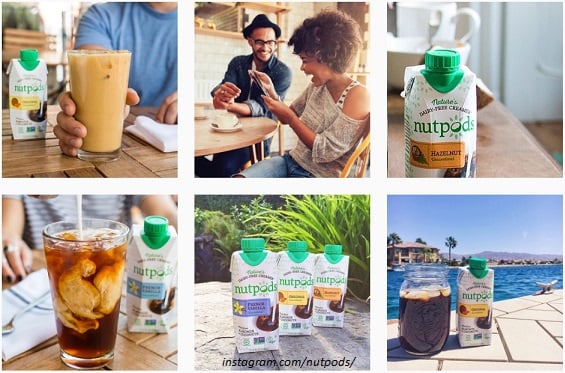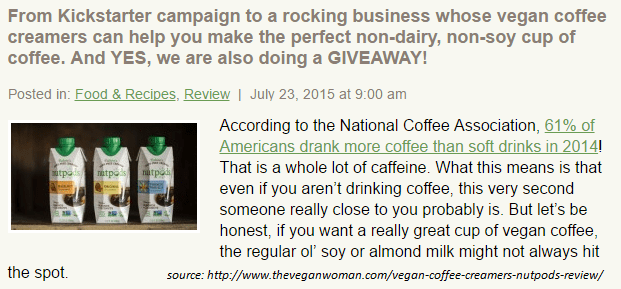Sampling is an age-old strategy to get your products in the hands of influential people. In the digital age, this has become even easier. Bloggers are now building niche audiences around every conceivable topic. If you can get in front of these small, passionate groups, you can connect and establish relationships that drive sales, valuable feedback and momentum for your business.
While the opportunity is obvious, the strategy isn’t. If there’s anything we’ve learned from working with hundreds of CPG entrepreneurs, there’s nothing like free product to get the attention of influencers. To better understand the nitty gritty of influencer marketing, we sat down with Nutpodsfounder Madeline Haydon to understand how she is using free products to generate press and sales.

Understand the Opportunity
Madeline’s story is similar to so many companies trying to get off the ground. “We’re a startup,” she explained. “We had limited funds and were trying to keep up production. We just didn’t have a lot of inventory to sample.”
In the early days, it’s just too expensive to hire a PR agency or pay celebrities to endorse your product. Building relationships with niche bloggers is much more cost-effective.
Where there used to be a handful of mainstream publications, there are now millions of blogs. The audiences are (usually) smaller than huge publications like Consumer Reports or the New York Times, but the fragmentation means that passionate people can bond around more personal issues and influencers. If there’s a niche, there’s a blog.
This benefits the consumers—who now have plenty of places to go to get good information—as well as entrepreneurs. You don’t need to spend much up front to get products into the hands of bloggers.
Sending a few free samples of your product to the New York Times is unlikely to get you coverage. But niche bloggers are investing in their own audiences and are curious about new products. If you’re tactical about which bloggers you contact and how, you’re sure to get covered.
Find Your Niches
Madeline Haydon created a dairy-free creamer because she’s lactose intolerant and wasn’t thrilled with the options at her local grocery stores or online. It turns out she wasn’t alone.
At first, Madeline was only thinking about her most obvious niche—the lactose intolerant community. But when the product got into the hands of more consumers, she realized how much opportunity she was missing out on. Here are just a few clues that people left in their reviews:
- “As a diabetic I’m always looking for things I can have and these are sugar-free and delicious! 🙂 LOVE THEM SO MUCH!”
- “I am so happy to have found this!! Recommended on a Whole30 website. Very delicious!”
- “The best paleo creamer I’ve tried.”
- “Love this product! As a vegan I was looking for a decent creamer that wouldn’t break up when added to hot coffee.”
As the feedback flowed, Madeline realized that her product appealed to a number of distinct but overlapping groups of people. It was vegan, gluten-free and unsweetened, meaning that people who were diabetic or on stricter diets—such as Paleo or Whole30—would be interested. Each group led her to niches that were served by blogs, Facebook groups and social channels.

This data informed her buyer persona. It’s easy to guess that a health-conscious person between the ages of 25 and 34 would like the product, but it’s a game-changer when people identify who they are and why they want it. As a result, Nutpods knew which certifications to seek out. Getting a stamp of approval from Whole30 and the Non-GMO Project means she has credibility with influencers and customers in those circles.

Madeline advises entrepreneurs to use data like this to understand all the groups of people that could be interested in your product, then work backwards to find out what blogs they read and who they follow on Instagram.
Tools like Buzzsumo make it really easy to find blogs and find the people who share their content on Facebook, Pinterest and Twitter. Simply do a search for your product category along with some buyer persona keywords and Buzzsumo will return the most popular blog posts on the topic.

Click “View Sharers” to see exactly who’s sharing the article. Now you have the names of the blogger and the readers. Click “View Backlinks” to see what other sites link to those blogs.

There’s opportunity everywhere—across social media, on forums, subreddits, newsletters, and so many other places. The deeper you go, the more communities you’ll find.
Establish the Relationships
The next step is actually reaching out to these folks to see if they’d be interested in reviewing your product. But bloggers don’t bother with every email sent their way. Here’s what you have to do to make sure influencers take you seriously:
- Reach out to only the most relevant bloggers and influencers.
- Find bloggers whose audience would actually care about your product.
- If they have information on their site about solicited reviews, read it and follow their instructions.
- See if they’ve reviewed or partnered with your competitors.
- Offer free products with no strings attached.
To get responses, you’ll need to reach out to a lot of bloggers. This can get messy, so you need a system to keep track of all these moving parts. Create a simple spreadsheet to keep track of all the blogs that cover products in your area or that overlap. This acts like a simple CRM and will make your life a lot easier.

Too many new entrepreneurs approach influencers on an ad hoc basis. They find a blogger, reach out, hear crickets, and try again another time. But if you keep your influencers in an organized list, you’ll begin to see patterns in what approaches work and don’t work. If you’re not getting any bites from a certain niche, re-evaluate your approach or re-focus on different niches.
Tactful outreach certainly worked well for Nutpods. Here’s an example of a post that was the result of a free sample:
http://meghanonthemove.com/nutpods-whole-30-iced-coffee/
As word spread, people began writing unsolicited reviews, like these:



You may find that there are 50, 100 or even more bloggers that you want to reach out to. Copying and pasting your script into Gmail will get old, but there are plenty of simple CRM tools like Highrise, Nutshell and Pipedrive that you can pair with Zapier to automate this process for you.
Never Underestimate the Power of “Free”
The Internet is the ultimate selling machine. And while it can be used to reach consumers all over the world, it can also be used to run grassroots marketing campaigns that get your product in front of passionate niche audiences.
Never underestimate the power of free. Even a small investment in free samples can go a long way towards establishing your brand and growing your business.
Sign up for our newsletter! Email us at info@circleup.com
/Hero%20Backgrounds/Gradient-Sun-med.jpg?width=300&name=Gradient-Sun-med.jpg)